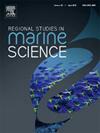Contamination, potential sources, and risk assessment of microplastics in surface waters of two public bathing beaches along the Northern Bay of Bengal
IF 2.1
4区 环境科学与生态学
Q3 ECOLOGY
引用次数: 0
Abstract
Understanding microplastics (MPs) pollution and its associated risks in bathing beaches, particularly those characterized by heavy commercial trading, is essential for the protection of marine ecosystems and human health. Despite the global concern regarding MPs, contamination levels along the Bangladesh coast, especially on popular bathing beaches, remain largely unexplored. This study aimed to investigate the levels, characteristics, and associated risks of MPs at Patenga and Parki beaches along the Bay of Bengal coast. The results revealed that MPs concentrations ranged from 305.56 to 116.67 MPs/m³ at Patenga and from 250.00 to 83.33 MPs/m³ at Parki Beach, indicating significant differences in contamination levels between the two sites. The predominant characteristics of the MPs included violet coloration, fibrous structures, and sizes measuring less than 0.5 mm, with identified polymers such as PET, PP, PS, ABS, PE, and Nylon. The pollution load indexes (PLI) for both beaches exceeded 1, highlighting substantial risks to the marine ecosystem. The Coefficient of Microplastic Impact (CMPI) indicated varying degrees of impact, ranging from severe to minimal, while the polymeric risk evaluation (Hi) suggested considerable risks, particularly at Patenga. Furthermore, the MPs pollution risk index (PRI) values indicated a higher threat level at Patenga (HPatenga = 7.9) compared to Parki (HParki = 1.9). The Microplastics Pollution Index (MPPI) further indicated a significant abundance of microplastics, with Patenga exhibiting higher levels than Parki. These findings led to the development of a conceptual model illustrating the sources and transport pathways of MPs, underscoring the urgent need for effective management strategies to mitigate MPs pollution and safeguard public health on these bathing beaches.
求助全文
约1分钟内获得全文
求助全文
来源期刊

Regional Studies in Marine Science
Agricultural and Biological Sciences-Ecology, Evolution, Behavior and Systematics
CiteScore
3.90
自引率
4.80%
发文量
336
审稿时长
69 days
期刊介绍:
REGIONAL STUDIES IN MARINE SCIENCE will publish scientifically sound papers on regional aspects of maritime and marine resources in estuaries, coastal zones, continental shelf, the seas and oceans.
 求助内容:
求助内容: 应助结果提醒方式:
应助结果提醒方式:


